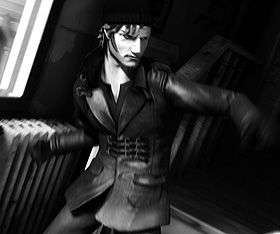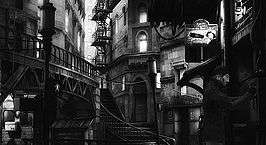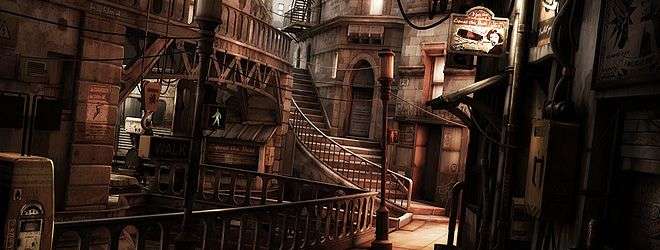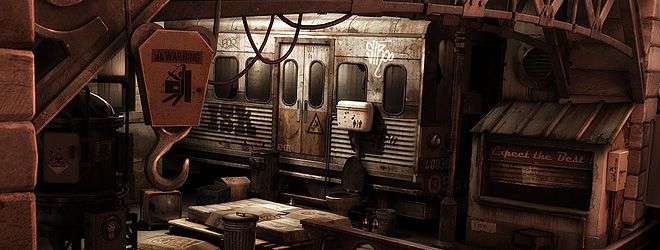Red Johnson’s Chronicles – Review
by Ric
|
 Lexis Numérique isn’t exactly a big company, but it’s certainly ambitious. A quick look at its upcoming titles include a kid’s game that utilises the Playstation Move, a survival horror, and an urban thriller. Here, we have their latest title, a point ‘n’ click adventure by the name of Red Johnson’s Chronicles. The game puts you in the shoes of Red Johnson, a private eye who’s been landed with a murder to solve because the police are, supposedly, overloaded with cases to solve. It appears someone’s been shot on a bridge and has fallen into the canal, while a security camera caught the whole thing. However, what at first seems like an open and shut case steadily becomes more convoluted as you meet a range of suspects, find evidence and eventually have to piece together what actually happened.
Lexis Numérique isn’t exactly a big company, but it’s certainly ambitious. A quick look at its upcoming titles include a kid’s game that utilises the Playstation Move, a survival horror, and an urban thriller. Here, we have their latest title, a point ‘n’ click adventure by the name of Red Johnson’s Chronicles. The game puts you in the shoes of Red Johnson, a private eye who’s been landed with a murder to solve because the police are, supposedly, overloaded with cases to solve. It appears someone’s been shot on a bridge and has fallen into the canal, while a security camera caught the whole thing. However, what at first seems like an open and shut case steadily becomes more convoluted as you meet a range of suspects, find evidence and eventually have to piece together what actually happened.
The developers should be commended for designing such a wonderful environment; the city of Metropolis has a beautifully dingy run-down feel to its back streets and crappy apartments, while also managing to feel quite European – as if it’s been taken out of a French cartoon. There’s also a nice ’50s vibe running throughout, from the old style security cameras to the small but noticeable newspaper ads you’ll occasionally see.
The characters, sadly, don’t quite match up to the environments. Although the actual models are fairly detailed, the animation during conversations is lacking and uninteresting, with all the emotion coming from the voices rather than the characters themselves. The lip-syncing, or lack thereof, is probably the biggest complaint I have with it; it’s such a shame to have a game with a large chunk of dialogue using fish-lips animation and it detracts from the experience. There’s also an odd design choice going on, where all the cut-scenes involving large amounts of animation feature the screen going black and white, which doesn’t add anything to the experience and seems a bit pointless.
Red Johnson’s Chronicles plays out like a regular point ‘n’ click; you move the cursor across the screen, clicking on interesting looking objects that may well lead to a puzzle you need to solve in order to gather more evidence for your case. The game offers a fairly large circle to look around with, which you can use to zoom in; when you roll across something you can interact with a symbol appears in the top right of the circle, so you know what clicking on the object may lead to. A gear symbol usually means there’s a puzzle coming, a hand means it’s evidence to pick up, and an eye gives you some insight into the object. This brings us to the first big problem in gameplay: the difficulty. With such a large margin for error when looking around the environments, it’s a little too easy to gather all the evidence you need by just spinning the left stick around the room and pressing X when the symbol changes. It makes some puzzles easy too; when searching for fingerprints on items, you barely even have to look at the object itself, and can just wiggle the stick around until it lets you take the fingerprint.
 However, while the investigation side of things is easy, the puzzles can be crushingly difficult. I’ll be honest, I don’t have much experience with adventure games and their puzzles, so it could just be that I’m no good at them, but I’m slightly ashamed to say that after twenty minutes of being stuck on one problem I turned to a walkthrough to help me out. There’s no real difficulty curve either; some puzzles halfway through the game are easier than ones found early on. Worse still, for a game with about ten puzzles in total, the second one in the game, involving sliding tiles around to make the right path, is repeated later on which is borderline lazy.
However, while the investigation side of things is easy, the puzzles can be crushingly difficult. I’ll be honest, I don’t have much experience with adventure games and their puzzles, so it could just be that I’m no good at them, but I’m slightly ashamed to say that after twenty minutes of being stuck on one problem I turned to a walkthrough to help me out. There’s no real difficulty curve either; some puzzles halfway through the game are easier than ones found early on. Worse still, for a game with about ten puzzles in total, the second one in the game, involving sliding tiles around to make the right path, is repeated later on which is borderline lazy.
Of course, if you get truly stuck and need some help without resorting to the internet, you can always call in your informant, Saul, for a clue. For $100 per clue, Saul will give you a handy hint on how to solve the latest conundrum. This is all well and good, but they are actually fairly useless; the first clue always points out the absolutely bloody obvious, and you have to buy them in order, so you’re always forced to listen to a smug sounding Saul explaining that the place you’re currently looking is, in fact, the place you should be looking. Even as you progress through the clues, he’ll never actually give you anything that you couldn’t quite easily work out for yourself, and will never actually give the solution to the puzzle itself. This is great if you’re big on point ‘n’ clicks, since it forces you to sit and work it out, but for a more casual puzzler such as myself, it was infuriating that the game refused to just let me get through the puzzle and carry on with the story.
The puzzles themselves, while hard, are actually pretty well crafted and upon completion Red will explain how it’s solved, so if you just fumbled around with every option until you got it right, you’ll find out how it was supposed to be done. The game will test your knowledge of maths and geography in the same problem, as well as religion in one particularly long-winded tarot card caper, which acts as the game’s last big puzzle. The interaction with the puzzles is enjoyable; most require some manipulation of objects with both the left and right stick to help find the solution and, other than the repeated sliding puzzle, each one is original and challenges you in a different way. In spite of this, I still couldn’t help but feel that I’ve done them all before in other games; they even managed to throw in the water container puzzle (as in Die Hard With A Vengeance, where you have to end up with four litres of water by utilising two containers which measure three and five litres respectively).
On the subject of things that have been done before, Red Johnson’s Chronicles also throws in the long-running joke that is quick-time events. Ordinarily I’d be fine with a couple of QTEs in the middle of the game, but when they last about thirty seconds each, have fairly short reaction time limits (where fluffing even one action leads to instant failure and having to re-do the entire sequence again), they can become annoying as the game progresses. Luckily, there are only five to be dealt with, but at the same time you can’t help but feel they’re totally unnecessary. Completing a puzzle earns you a ranking based on how long it took you to solve it, how many clues you used, and awards you an amount of money based on your ranking. So, the worse you do in the puzzle, the less money you make, which makes sense until you realise that if you suck at puzzles and need clues to help you, then you won’t earn as much cash, meaning you may find yourself stuck for far too long than is enjoyable later on. Again, this is fine for someone who plays plenty of adventure games, but it’s slightly harsh on the casual folks.
After you’ve finished gathering evidence, it’s usually a good idea to head back to your HQ, which opens up a whole variety of options. Of course, these options only become available to you when you need them, so there’s not much point trying to mess with stuff until the game tells you that it’s okay to. The main tools you’ll use are the Analyzer and the Comparator, which allow you to investigate pieces of evidence and then compare them with others in order to work out who they belong to, where they may have come from, and so on. This works fine, but towards the end of the game you’ll have about twenty items to choose from, and the developers saw fit to stick every item on one circle, so you’ll have to trawl through about ten useless objects (which can’t be dropped), just to reach the one you want to compare, and then do the whole thing again for the item you want to compare it with. Annoyingly, if you find two things that give you a new clue, you instantly get thrown out of the Comparator so that Red can discuss it with himself, meaning you have to click back into it and start the entire process again. A minor annoyance, certainly, but one that can get in the way of enjoyment.
 Other tools include the phone, which is used on two occasions for the same purpose, a map, which can’t be accessed until about halfway through the game and is mostly useless, the archives, which you use to get phone numbers, and the indictment drawer, which is used when you want to finish the story off and send someone to jail. Since the tools can only be used at specific times, the whole experience of being at your HQ feels very linear, and there isn’t much of interest to look at, making it something of a dull environment.
Other tools include the phone, which is used on two occasions for the same purpose, a map, which can’t be accessed until about halfway through the game and is mostly useless, the archives, which you use to get phone numbers, and the indictment drawer, which is used when you want to finish the story off and send someone to jail. Since the tools can only be used at specific times, the whole experience of being at your HQ feels very linear, and there isn’t much of interest to look at, making it something of a dull environment.
The final gameplay feature is conversations; obviously, throughout the game you’ll need to chat to some of the people of Metropolis to gather information and help you piece together what really happened. Conversations take place in some kind of shadow world, where the environment you were just in is turned into a dark background, which is disappointing given how wonderful they look. During conversations, you select what you’ve got to say with either thumb-stick in a manner very reminiscent of Fahrenheit (or Indigo Prophecy, if you prefer), although unlike the aforementioned game, choosing the wrong option leads to failing the conversation and having to start all over again, which is more than frustrating. It’s even more annoying when the conversation you’re having is actually just Red listing a bunch of idiotic things which serve no purpose other than to tack on another minute of gameplay, especially when one of the answers seems legitimate enough and you fail the conversation.
Thankfully, the vocal work is wonderful. With David Gasman, star of the previously mentioned Fahrenheit, playing Red, and a great cast of others handling the rest of the characters, so each one has at least some personality. Ringo the bum is slurry and crazy, Saul is cool and chilled, and the major suspect in the game has a great gangster voice which makes his character so much more interesting than he would otherwise have been. What a shame then that the script is lame and uninteresting. If you actually read what they’re saying in the subtitles, you find that it’s just cliché upon cliché of your typical murder-mystery dialogue, with nothing original or interesting. While the characters are well voiced, the rest of their personalities never shine through, so everyone seems quite one-dimensional. The only piece of backstory about our main man, Red, is hastily slapped on in the epilogue, making it feel forced and unnatural, and as if they deliberately held it back to set themselves up for a sequel, which they then proceed to do. Even the vague attempts at humour, such as Red’s fantasies about lying on a sofa with a hooker and ignoring the whole case feel forced, especially given that Red’s character is usually so straight forward and purely focused on the task at hand.
The characters aren’t the only thing that is flat either. The soundtrack is either non-existent or one looping funk track which gets old quickly. In fact, for the most part, it’s barely noticeable and after some digging around on the options menu it becomes apparent that the soundtrack is, by default, turned way down. It’s almost as if the developers realised that their soundtrack was dull and hoped that by quieting it down people just wouldn’t notice there was one there. Overall, the experience doesn’t last long. While the official line claims there is eight to ten hours of detective work to be had, my overall time was just under four hours for 100% completion, which is a little disappointing, but at least they didn’t attempt to drag out the game any longer than it really needed.
Pros- Wonderful 2D art and environments are a treat for the eyes
- Great voice work
- Some interesting puzzles
- 3D animation is lacking and dull
- Script and story are unoriginal and pretty cliché
- Puzzles can be frustrating and the clues don’t help much
- Having to re-do entire conversations and QTEs gets very annoying
Red Johnson’s Chronicles isn’t a masterpiece. It’s frustrating, clichéd and unoriginal, but for such a small development team, it’s certainly a good attempt. The great artwork and voice acting helps drag it from being a bad game to an okay one. I wouldn’t rush out and buy it, but if you’re a PS3 owner looking for a quick point ‘n’ click fix, you may want to check it out.
Last five articles by Ric
- Playing Rhiannon, With Rhiannon
- The Hidden Controversies of 2015
- Best of 2015: Tell No Tales
- Best of 2015: A Good Walk Spoiled By John
- Best of 2015: My Summer As A Drug Dealer























Great first review, Ric! Very detailed, and I appreciate how much of it is explained, because it went from “Ohh, point and click want want want” to making me think very carefully about the purchase. I think I’ll give it a miss, because the lacklustre story puts me off, but I wish them every bit of success!
Here’s to hopefully seeing more reviews from you soon